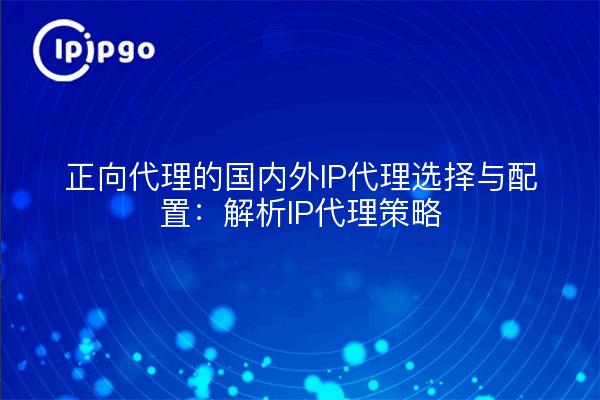
In the online world, we often need to use proxy servers to protect our privacy and increase access speed. Forward proxy is one of the common proxy methods. If you are looking for a reliable domestic and international IP proxy, then you have come to the right place! Today, we will discuss the selection and configuration of forward proxies, as well as the analysis of IP proxy policies.
Choosing the right domestic and international IP proxy
When choosing a domestic and international IP proxy, the first thing we need to consider is the stability and speed of the server. Imagine when you are browsing the web or downloading files, but the proxy server frequently loses connection or is slow, this will undoubtedly affect your network experience.
Secondly, we also need to pay attention to the geographical location of the proxy server. Proxy servers in different regions may have different access speed and availability. Therefore, according to your actual needs, choosing a region that is closer to you and has good internet connection as the proxy server location will be able to provide better stable and efficient service.
Configuring IP Proxy Policies
Once we have chosen the right domestic and international IP proxy, the next step is to configure the IP proxy policy. There are some key factors to consider here.
1. Protocol selection
When configuring an IP proxy, we need to choose the correct protocol. Common protocols include HTTP, HTTPS and SOCKS. Depending on the requirements of the website or application you are accessing, choosing the right protocol will ensure that the proxy server is able to communicate with it properly and provide the required functionality and security.
2. Authentication methods
Another important configuration is the authentication method. Some proxy servers require a username and password for authentication, while others may use an IP address or API key for authentication. Depending on the requirements of the proxy server you are using, make sure that the authentication method is configured correctly so that the connection is established smoothly.
3. Cache Settings
Finally, we can also set up caching settings according to actual needs. Proxy servers can cache some commonly used network resources to reduce the number of requests to the source server and improve access speed. However, if you are accessing dynamic content or sensitive data, you may need to disable the caching mechanism to ensure timely data updates and security.
summarize
By choosing the right domestic and international IP proxies and properly configuring IP proxy policies, we are able to better protect privacy and increase the speed of Internet access. Remember, stability, speed and geographic location are key factors to consider when choosing a proxy server. At the same time, configuring protocols, authentication methods and cache settings according to actual needs will be able to meet individualized proxy requirements.
I hope today's article has provided you with some insight into parsing IP proxy strategies. May you have a smooth internet experience!








